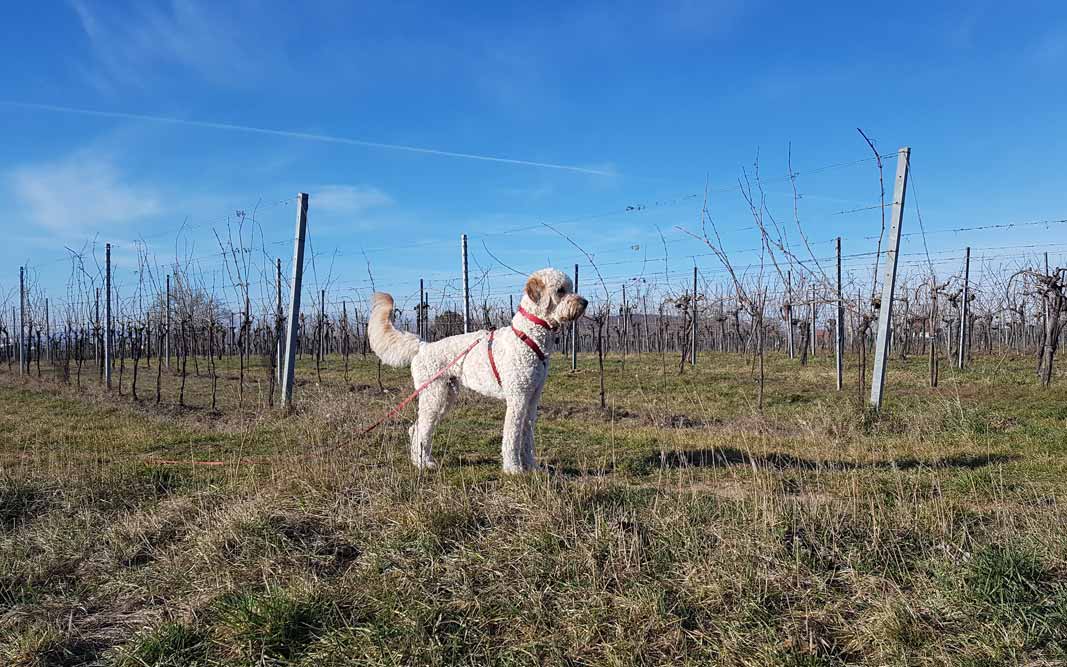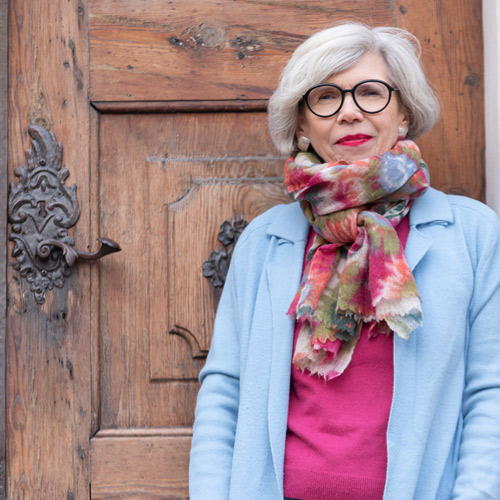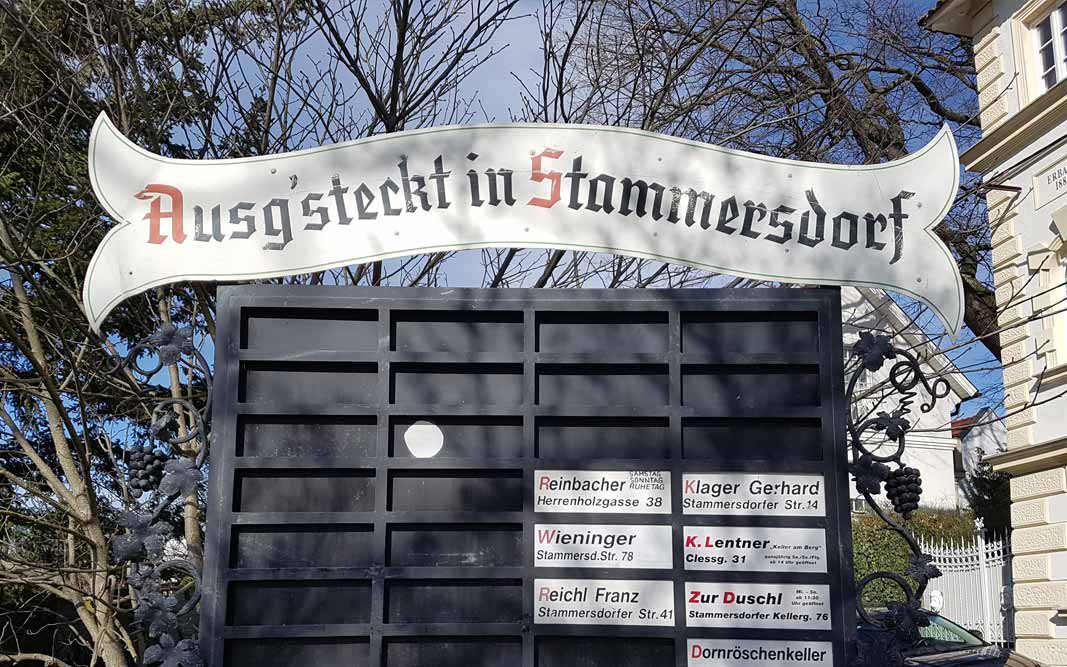Stammersdorf – where my granny was born and the wine tastes good .
With Heurigen glossary
My maternal grandmother, was born in Stammersdorf, from the Luckenschwemm to be exact, as she always said. Luckenschwemmgasse today leads from the new housing estates along Brünner Straße to the core of Stammersdorf, the village that was only incorporated into the 21st district(Floridsdorf) in 1938. The National Socialists created “Groß Wien” at that time and my granny was 17 and probably no longer lived with her parents and five siblings. Actually there were seven children, but the only son did not return from the First World War.
The circumstances were, as they say, “modest”. The father, my great-grandfather, whom I never met, was a vineyard guard. His job was to watch over the vineyard, prevent grape thefts and chase away birds. In Wikipedia I can read:
“In the selection of vineyard keepers, Austrian wine villages made sure that they were “righteous” men. Furthermore, they should be well acquainted with the the vineyard. Another requirement for their selection was good physical condition.”
Today Stammersdorf is a charming district, social housing can be found next to the neat petty bourgeois and middle-class houses of the winegrowers’ families, and in some places a modern single-family house appears. All in all, the character is still fairly rural and oriented at the image of the traditional wine village. The Stammersdorfer Kellergasse is – not only me as a quasi native of there – the most beautiful in Vienna, at least the most original and cozy. There are still traditional small wine taverns with vaults and terraces above old cellars, the opening days and hours of which can be found in theStammersdorf Heurigen Calendar online.
The Stammersdorf vineyards are located at the foot of the Bisamberg and red and white wines thrive here, including the typical Viennese Heurigen varieties Grüner Veltliner and Gemischter Satz.
Gemischter Satz …
… is a Viennese specialty that has been around since the 19th century. At that time, varieties such as Riesling, Pinot Blanc and Traminer were planted out mixed with other white wine varieties in the vineyard and the grapes were processed together in the wine cellar after the harvest. This gave rise to wines with very complex flavors.
At the same time, this method of planting helped to avoid total crop failures, as poor weather conditions at the time of flowering of one variety could be compensated by the better flourishing of another. Later, when single-varietal cultivation was considered the method of choice, the Gemischter Satz was considered less relevant and attractive. This changed a few decades ago, and today the Wiener Gemischter Satz is considered an identity-forming variety for Viennese wine and viticulture.
Besides drinking wine, I often come to Stammersdorf and the Bisamberg for a walk. With the dog. After all, I love cultural landscapes and the combination of unobstructed views and building structures that have grown over a long period of time. And the dog has to come along.
It is possible to walk among the vineyards, which look different almost every week due to the change of seasons from spring. In addition to the aforementioned Stammersdorfer Kellergasse, there are other alleys and hollow ways lined with wine cellars that make for pleasantly cool walks, especially on summer mornings.
By the way, Stammersdorf can be easily reached by public transport. As early as 1886, a steam tramway operated on the route “Vienna – Floridsdorf – Stammersdorf”. Today, streetcar line 31 covers the distance from the city center to Floridsdorf in 36 minutes. With possible transfer at Floridsdorf station, where there is a connection to the subway and rapid transit network. From the streetcar station on Brünner Straße, it is just under 20 minutes’ walk to Kellergasse, which in any case only reveals its full beauty to pedestrians. They also have the pleasure of being able to stop at one or another open wine tavern on their way through the alley.
If you want to get to know Vienna’s wine culture away from the big wineries and tourist hotspots, this is the best way to go. I will gladly accompany you on this discovery tour.


Heurigen glossary
Heuriger
“Heuriger” is the name given in Vienna to the wine of the latest harvest. It is also the name given to establishments run by winegrowers, where they serve their own wine and are allowed to serve food with it. Originally, these were only cold dishes. Today, almost all Heurigenlokale also have warm dishes on offer. However, in some small Heurigen still only a cold buffet is available
”Aus’gsteckt”: We are open
The fact that winegrowers served their wine and drew attention to it by hanging a bundle of brushwood over the cellar door – they call it “aus’gsteckt” – has been handed down since the 15th century. Under Emperor Joseph II, at the end of the 18th century, winegrowers were allowed to serve wine and grape juice and to sell food they had produced themselves. This gave rise to many small pubs in the suburbs and suburbs, which were always popular with the Viennese. Today there are about 100 Heurigen establishments in Vienna.
Eighth, quarter, half liter…
The traditional order at the Heuriger is the quarter, i.e. 0.25 liters of wine, unless a half liter or liter is ordered together for the whole table. Most often, these are the simpler draught wine varieties, which are not specified. So we order “a liter of white”. Due to the development of Viennese viticulture in the direction of quality wine, it has become quite common to order varietal wines by the glass, i.e. as “eighths” = 0.125 liters, even at the Heuriger. Viennese wine drinkers frequently use the diminutive form “Achterl” in an affectionate, connoisseurial manner.
Kracherl
The classic children’s drink at the Heuriger, sparkling lemonade, used to be called Kracherl and was available in white (lemon) and red (raspberry). The name “Kracherl” probably comes from the original closure, which made a “cracking” sound when opened due to the escape of carbon dioxide. My favorite brand was the red Rax-Kracherl, which had an edelweiss adorning the label – reminiscent of the Lower Austrian mountain named Rax.
Spritz
“Gespritzter” is a very popular and almost legendary drink in Vienna. Mostly white, much less often red: wine mixed with soda water in a ratio of 1:1 (“Spritz”). As a “summer Spritz” even more diluted: wine to water 1:3 and in half-liter size.
Soda
Actually soda water: carbonated water. Essential for the production of a Spritz. Refreshing also when mixed with grape juice, apple juice, etc. The latter is called “Obi Spritz” in Vienna, wherein an old brand name for apple juice has been preserved.
Martini
November 11, Saint Martin’s Day, is the day when the wine of the previous year is called “old” and the freshly pressed “Heurige” is served. It is then drunk with great pleasure with the traditional Martini goose.
Liptauer
Liptauer is “the” snack at the Heuriger. The orange spread, classically prepared with sheep’s cheese (Brimsen), paprika, onion and caraway seeds and seasoned with anchovies, capers and mustard, comes to the table either in the form of a Liptauer bread or it is served in a small bowl from which it is nibbled with the help of soletti – see below.
Soletti
Soletti are thin salt sticks that share dough and flavor with salted pretzels. Soletti is the brand name of this salty snack, which was invented in 1949 by the Zach bakery in Feldbach, Styria, and is still part of every Heurigen visit and every party. We use “Soletti” in Vienna as a synonym for any salt sticks 😉
Grammelschmalz and Bradlfettn
Fatty foods slow the absorption of alcohol into the blood. This is probably why hearty snacks are so popular at the Heuriger. Lard is melted fat from pigs (but also from geese) that can be enjoyed as a spread. Grammelschmalz contains the remains of the fried bacon parts, the so-called Grammeln, which are enjoyed by lovers richly salted also as their own snack. Bratenfett – we call it “Bradlfettn” in Vienna – is produced as a by-product during the production of a pork roast and is composed of lard and jellied gravy. Both are mixed together and put on the bread.
Pischinger
Yet another brand name that has taken on a life of its own. This refers to chocolate-covered wafers made by the Pischinger company, which was founded in Vienna back in 1842. The “Pischinger Torte” a large round wafer (sold as almond or hazelnut cake), has been around since 1880 and is traditionally the “dessert” of a Heurigen menu, shared around the table. You can also buy Pischinger cakes in the supermarket and eat them at home, but somehow it doesn’t feel right.
Grüner Veltliner,
Gemischter Satz and others
Grüner Veltliner and Gemischter Satz are the classics among Viennese wines. However, Viennese viticulture is more diverse than that and it is worth asking about the specialties of each winemaker and tasting several varieties.More information about Viennese wine can be found here: https://www.wienerwein.at
Don’t drink and drive
In Austria, 0.5 per mille blood alcohol level is the maximum limit for driving a vehicle (note: also applies to bicycles). Apart from the fact that drunk driving is a great danger for all road users, it is also punishable by fines and in serious cases the driver’s license is revoked. For a relaxed visit to the Heuriger, therefore, “Don’t drink and drive”! The Heurigen places in Vienna are easily accessible by public transport and sometimes a cab for the way home is simply the best idea. Cheers!



